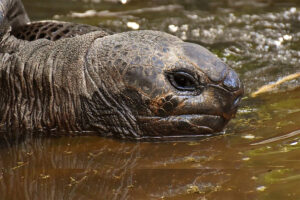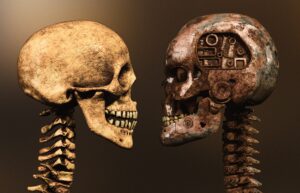Traditionally, human groups have felt a particular fascination for settling near mountainous enclaves, not only because of the beauty that usually emanates from these sites, but also because they represent an important source of basic supplies for human life, particularly when one of these mountains is a volcanic geological structure.
Because despite how destructive they can be during some episodes of their geological “life”, volcanoes provide endless useful materials for human settlements; various rocks for making utensils for hunting and gathering, for polishing metals, for making ceramics and, of course, for the construction of houses and monuments. Above all, one of the main benefits generated by volcanism is the formation of aquifers and springs from the water that is contained in volcanic rocks, which in addition to its usefulness for agriculture, livestock, and even for power generation, renders it useful for human consumption.
And when they are also located in tropical areas, which tend to have heavy rainfall, volcanic soils tend to be much more fertile due to the alteration that water causes to the volcanic materials exposed to the surface.
Traditionally, human groups have felt a particular fascination for settling near mountainous enclaves, not only because of the beauty that usually emanates from these sites, but also because they represent an important source of basic supplies for human life, particularly when one of these mountains is a volcanic geological structure.
In the department of Sololá, in Guatemala, almost three hours from Guatemala City, one of these hydrographic accidents is precisely the product of volcanic action, Lake Atitlán, which occupies an imposing volcanic caldera formed between 85,000 and 65,000 years ago. Due to the permanent volcanic activity that continued years after its origin within the caldera itself, three volcanoes were formed that today constitute the southern limit of the lake: the Atitlán, the Tolimán, and the San Pedro la Laguna (The Three Giants).
Lake Atitlán is one of the most important lakes in Central America, and represents one of the main economic sources in the area, due to the tourist and commercial contribution that is generated among the communities that surround it, such as Panajachel, probably the most emblematic tourist site in this region. It is nestled between the central mountains of Guatemala, more than 1,500 meters above sea level, reaches a depth of 320 meters, and occupies an area of around 130 square kilometers.
Of course, when looking at the majesty of the imposing lake today, it would be impossible to think that a human settlement could be established within its own confines. However, thanks to the discovery made by a Guatemalan diver at the end of the last century, underwater archaeological investigation starting in 2008 “revealed” that around 1700 years ago, when the water level was at least 25 meters lower than it is today, there were three islands on the south side of the lake. On one of these islands, they found vestiges of an ancient Mayan population that inhabited this charming area, until the dynamic forces of nature completely covered the small community, today known as Samabäj.
However, thanks to the discovery made by a Guatemalan diver at the end of the last century, underwater archaeological investigation starting in 2008 “revealed” that around 1700 years ago, when the water level was at least 25 meters lower than it is today, there were three islands on the south side of the lake. On one of these islands, they found vestiges of an ancient Mayan population that inhabited this charming area.
So far, various pieces of ceramic have been found, as well as structures that refer to rectangular bases, possible bleachers, some circular structures, small bases for docks, and a closed square built in the highest part of the land, which possibly functioned as a public space for the performance of rituals. In its interior, 11 monuments have been found thus far, in addition to some smooth steles. Excavations have also recovered non-human animal bones, and even a burned human tooth.
In another area of the site, small circular structures have been found, with a diameter of just 1.25 meters, which are quite well preserved. Due to their shape, it is presumed that they could have been steam baths, the so-called temazcalli, widely scattered in different Mesoamerican enclaves, which would have been used regularly for ritual and medicinal purposes, and probably also as places for hygiene, rest and relaxation. Even today, in some towns of the Guatemalan highlands, such as San Lucas Tolimán and San Pedro la Laguna, settled on the shore of Lake Atitlán, steam baths are still associated with domestic areas, and related to healing rituals (limpias) or to after childbirth.
It seems that since its origins, the areas that today surround Lake Atitlán, including the central part, crowned by what is now the archaeological zone of Samabäj, must have been recurring sites for trade and political/religious activities, in addition to spaces for spiritual healing or body relaxation. This can be fully appreciated on a visit to Panajachel, the epicenter of the lake’s tourist activities, a place that has beautiful nature reserves, good bars and restaurants, the famous Santander street, the Chichicastenango market, the San Francisco church, the Lake Museum, also known as the Museum of Underwater Mayan Archeology, and good places to stay, for all budgets, such as the Hotel Posada de los Volcanes, but above all, a spectacular view of the three volcanoes that surround Lake Atitlán.
This is also a good starting point to visit the other communities by boat that surround the lake, where some descendants of Cakchiqueles and Tzutujiles, ethnolinguistic groups of Toltec-Maya origin, still live.
Panajachel offers a spectacular view of the three volcanoes that surround Lake Atitlán. This is also a good starting point to visit the other communities by boat that surround the lake, where some descendants of Cakchiqueles and Tzutujiles, ethnolinguistic groups of Toltec-Maya origin, still live.
According to some sources, such as the Popol Vuh or the Sololá Memorial, these settlers arrived in the Guatemalan highlands from the first migrations from the mythical Tollan or Tulán, a great mecca of antiquity, a great Mesoamerican center of power, of convergence and dispersion of people from various regions, some of which, once they left the enigmatic city, began a diaspora that would lead them to settle in the highlands of what is now Guatemala.Sama.
Chichén Itzá flourished during the early Mesoamerican postclassic, a metropolis that between the 8th and 13th centuries seems to have dramatically integrated the ancient Mayan legacy, with the political, religious and cultural influences originating in both, Teotihuacán and Tula, and whose disintegration of power coincides with the diaspora of both the K’iche’s and the Kaqchikels towards Central America.
Even today there is still a controversy over whether the mythical Tulán is one of the two main cities of the classic and late classic period of the central Mesoamerican highlands, Teotihuacán or Tula, whose fall (Tula) is argued by scholars to be one of the reasons for the displacement of the Mayan people K’iche and the Kaqchikel, or if it is Chichén Itzá, the powerful Mayan city of the east from the Yucatán Peninsula. Chichén Itzá flourished during the early Mesoamerican postclassic, a metropolis that between the 8th and 13th centuries seems to have dramatically integrated the ancient Mayan legacy, with the political, religious and cultural influences originating in both, Teotihuacán and Tula, and whose disintegration of power coincides with the diaspora of both the K’iche’s and the Kaqchikels towards Central America. It also seems that the cultural and social traits of the migrant groups that inhabit the mountainous area of present-day Guatemala are better identified with the traditions of Chichén Itzá than with those of Tula.
Finally, the most important thing that this enormous web of ancestral migrations between populations in the central part of the American continent teaches us, it is that humans are migrant primates by nature, and that thanks to these endless demographic dynamics, human populations constantly enrich their biological and cultural heritage, something that should surely never be belittled, and that is evident when you visit one of the current towns that surround the charming Lake Atitlán.
And that thanks to these endless demographic dynamics, human populations constantly enrich their biological and cultural heritage, something that should surely never be belittled, and that is evident when you visit one of the current towns that surround the charming Lake Atitlán.
References
Recinos, Adrián (Trad.). 1947. Popol Vuh. Libro del Común de los Quichés. Colección Literatura Latinoamericana. Casa de las Américas. La Habana. Cuba.
Carmack y Mondloch. 1983. El Título de Totonicapán. Universidad Nacional Autónoma de México / Instituto de Investigaciones Filológicas (UNAM) / Centro de Estudios Mayas (UNAM) (Fuentes para el estudio de la cultura maya; 3).
Recinos, Adrián (Trad.). 1950. MEMORIAL DE SOLOLÁ. ANALES DE LOS CAKCHIQUELES. Traducción directa del original, introducción y notas. México, D.F.: Fondo de Cultura Económica.
Florescano, Enrique. 2004. Quetzalcóatl y los mitos fundadores de Mesoamérica. Editorial Taurus.
Medrano, Sonia. 2015. “Samabaj, una isla sumergida en Atitlán”. Arqueología Mexicana núm. 134, pp. 44-49.
Trained as a biological anthropologist, he is a doctoral student at the National School of Anthropology and History (ENAH), where he studies the processes that develop creativity and innovation in humans, within the framework of institutional education, under the guidance of the professor Agustín Fuentes. He collaborates with the curatorship of the Introduction to Anthropology and Populations of America rooms of the National Museum of Anthropology, and he is also common people.
“I came to Mexico City because they told me that my father, a certain Juan Vaca, lived here. My mother Teresa García told me”.
I am a Chilango grateful for public education. I graduated from Journalism at National Autonomous University of Mexico (UNAM) and since 1998, I decided to stop living in error, although with brief lapses in the written press and radio.
I have always voted for the left politics, and no, I have not been disenchanted with AMLO.


